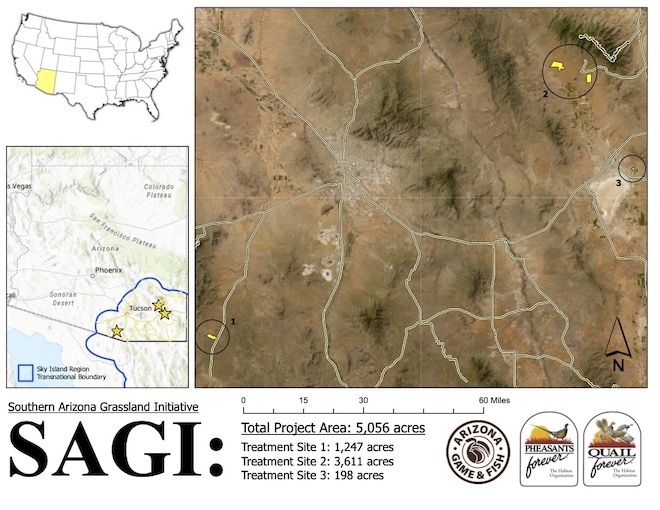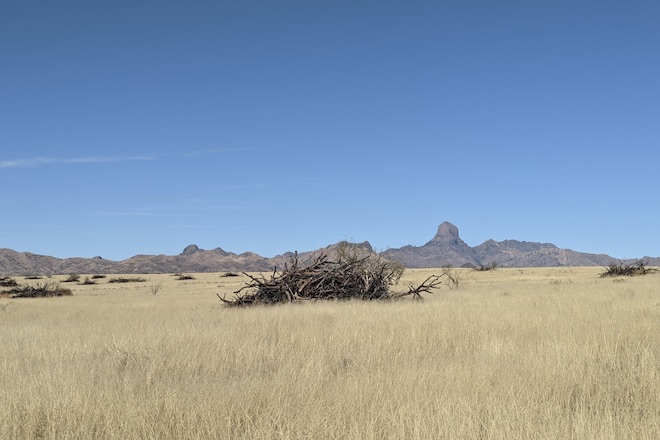Critical work being accomplished through the Southern Arizona Grassland Initiative
In southeastern Arizona, Quail Forever staffer Gerry Berthelette is working with a multitude of stakeholders to help restore habitat connectivity to a region featuring some of the highest levels of biodiversity on the planet - The Madrean Sky Islands.
A region of mountain ranges spanning several states and two countries, the Sky Islands ecoregion is aptly named for the 55 pine and oak-studded mountains varying between 3-10K feet in elevation and connected by incredibly vast grasslands.
But these landscapes are under attack.

“The unchecked spread of mesquite trees over the past 100 years is now taking a toll on species richness for the Sky Island Region,” said Gerry Berthelette, senior coordinating wildlife biologist for a shared partnership position between Quail Forever and Arizona Game & Fish Department. “In my main role, I’m helping to identify areas where grassland connectivity can be restored, contract the work, and reinvigorate mesquite-free grasslands throughout the region.”
Berthelette and partners are helping lead efforts of the Southern Arizona Grasslands Initiative (SAGI), an endeavor to restore 5,000+ acres of southeast Arizona's historic grassland habitats for grassland-obligate species affected by human-induced changes to the landscape and natural disturbance patterns. These unique, desert adapted species include, but are not limited to, the masked bobwhite quail, scaled quail, Gambel’s quail, pronghorn antelope, desert mule deer, and Coues whitetail deer. This beautiful ecoregion is even blessed with occasional glimpses of the endangered jaguar.
The work being done across public and private lands to restore mesquite-invaded grasslands is through mechanical “grubbing,” a selective technique to completely remove the tree – taproot and all – from the ground. This method has proven to have an immediate and long-lasting positive effect on the landscape by deliberately targeting each individual tree, as opposed to other broad-spectrum treatments like prescribed fire.

A recently completed mesquite tree grubbing project as part of the Southern Arizona Grassland Initiative shows a fully restored landscape with major benefits for quail, mule deer, pronghorn antelope, and other grassland-obligate species. (credit: Gerry Berthelette, Quail Forever)
Mesquite trees have adapted to invading desert landscapes and are aided by lengthy tap roots that reach deep underground, soaking up groundwater not accessible to plants and grasses with shallower root systems. They define the phrase “water hog.” And once established, mesquites shade out native species at ground-level revealing erosion issues, take a toll on water reserves for the desert Southwest, and break the connectivity of grasslands between Sky Islands.
Positive implications for the Southern Arizona Grassland Initiative include enhanced habitat for wildlife, increased connectivity, a reduction in soil erosion, and an increase in native species on the landscape. While grassland restoration has been ongoing in the region for more than a decade, SAGI has reinvigorated the effort and continues with 835 acres “grubbed” so far in 2023. It should be noted that 5,000 acres is a starting point, while total acreage continues to be increased as project areas are defined, and funding is procured.
The Initiative is a massive undertaking that could not be accomplished without a wide array of partners, communities, and local landowners. Input from various agencies such as the U.S. Fish and Wildlife Service, the Arizona Department of Forestry and Fire Management, the Arizona Game & Fish Department, the Arizona State Land Department, the Natural Resources Conservation Service, and the Fort Huachuca Sentinel Landscape are vital for the project. Additionally, local entities have participated in planning and implementation efforts including the Arizona Antelope Foundation, the Altar Valley Conservation Alliance, Southern Arizona Quail Forever, and the Arizona Association for Conservation Districts, not to mention all the contributions from landowners. Private landowners are crucial, and often times will provide public access in return for project assistance.
So, the next time you visit Arizona, seek out some of these projects to witness the incredible habitat work and associated wildlife thriving in Arizona’s Sky Island Region.